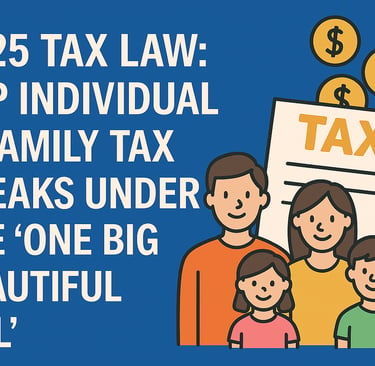2025 Tax Law: Top Individual & Family Tax Breaks Under the “One Big Beautiful Bill”
Explore the top individual and family tax breaks introduced by the 2025 One Big Beautiful Bill Act. Learn how permanent increases to the standard deduction, expanded child tax credits, new below-the-line deductions, senior-specific benefits, and innovative “Trump Accounts” can reduce your tax burden and boost your financial security. This comprehensive guide helps taxpayers navigate the latest tax changes for 2025 and beyond.


The One Big Beautiful Bill Act of 2025, signed into law on July 4, brings sweeping changes to how Americans save, spend, and reduce their tax bills. Whether you're a working parent, a retiree, or just starting out, the bill includes expanded deductions, new credits, and family-focused incentives that could make a meaningful difference in your financial life.
Here’s a breakdown of the most impactful personal tax changes—and how you can take advantage of them.
💰 1. Standard Deduction and Child Tax Credit Made Permanent
Two of the most popular benefits from the 2017 Tax Cuts and Jobs Act are now here to stay.
Standard Deduction:
The doubled standard deduction is now permanent:
$15,750 for single filers
$31,500 for married couples filing jointly
Indexed annually for inflation
This simplifies filing for most taxpayers and reduces the need to itemize deductions—while putting more money back into your pocket.
Child Tax Credit (CTC):
Increased to $2,200 per child
Now indexed for inflation, so it won’t lose value over time
Income phaseouts remain generous, making it accessible to middle-income families
📌 Example: A family with two children under 17 can receive up to $4,400 in tax credits—dollar-for-dollar reductions of their tax bill.
💼 2. New “Below-the-Line” Deductions (2025–2028 Only)
The bill introduces a set of temporary personal deductions that are designed to support workers, service employees, and consumers.
What’s Included:
Up to $25,000 in tip income deductions (for hospitality/service workers)
$12,500 deduction for eligible overtime pay
$10,000 deduction for U.S. vehicle loan interest
These are "below-the-line" deductions, meaning they reduce your adjusted gross income (AGI) and can help more people qualify for other tax credits or deductions.
📌 Use Case: A restaurant server who earns $20,000 in reported tips could deduct that income directly—potentially resulting in significant tax savings.
🧓 3. New $6,000 Additional Deduction for Seniors
Seniors age 65 and older now receive an additional $6,000 deduction if their income is below certain thresholds.
Applies on top of the standard deduction
Designed to reduce taxable income for lower- to middle-income retirees
📌 Example: A retired single taxpayer with $35,000 in income could deduct $21,750 in total (standard + senior deduction), making much of their income effectively tax-free.
❤️ 4. Above-the-Line Charitable Deduction for All
Previously, charitable deductions were only available to taxpayers who itemized. Now, everyone can deduct charitable giving, even if they take the standard deduction.
New Limits:
Up to $1,000 for individuals
Up to $2,000 for married couples filing jointly
Must be cash donations to qualified nonprofits
📌 Benefit: Encourages more Americans to support charities—and rewards everyday generosity with tangible tax benefits.
👶 5. “Trump Accounts” for Newborns (2025–2028 Only)
A headline-grabbing new provision, "Trump Accounts" are tax-advantaged savings accounts created for children born between 2025 and 2028.
Key Features:
The federal government contributes $1,000 at birth
Parents and guardians can contribute additional funds
Investment growth is tax-free, similar to a Roth IRA or 529 plan
Designed to support long-term financial security and wealth building
📌 Planning Tip: These accounts could be used for future education, home purchases, or retirement—making them a valuable early investment tool.
⚠️ Coming in 2026: 0.5% AGI Floor on Itemized Charitable Deductions
Starting in 2026, individual taxpayers will need to exceed a 0.5% of AGI floor to deduct charitable contributions through itemizing.
This won’t impact the above-the-line deduction (see #4), but does affect higher earners or those who itemize
It’s important to plan large charitable gifts accordingly
📌 Example: A taxpayer with $200,000 in AGI would need to donate at least $1,000 before any itemized charitable deduction would count.
💡 Final Thoughts for Individuals and Families
The 2025 tax law delivers meaningful tax relief and financial support to individuals across all life stages—from young families to retirees. With higher deductions, expanded credits, and new savings tools, it’s an ideal time to:
Review your withholding
Optimize retirement contributions
Plan charitable giving
Explore savings strategies for your children
At Acctually, we help individuals and families navigate complex tax changes with ease. Whether you’re planning for next April or the next decade, our expert advisors are here to support you.
📞 Ready to Maximize Your Tax Benefits?
Let’s talk.
📅 Book a free strategy session with an Acctually tax expert and discover how to make the 2025 tax law work for you.
📧 Email us at hello@acctually.com
🌐 Visit us at https://acctually.com/
📞 Call us at (646) 543-4916
